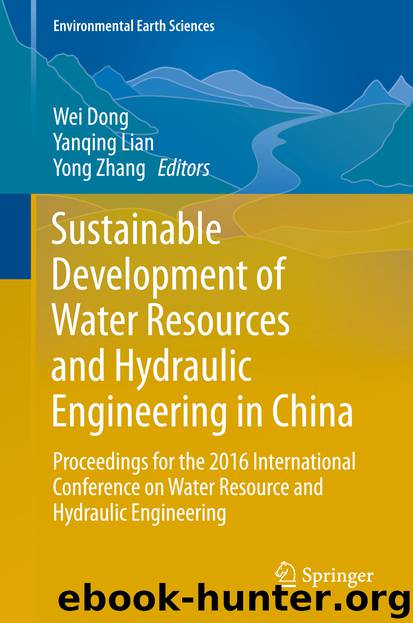Sustainable Development of Water Resources and Hydraulic Engineering in China by Wei Dong Yanqing Lian & Yong Zhang

Author:Wei Dong, Yanqing Lian & Yong Zhang
Language: eng
Format: epub
Publisher: Springer International Publishing, Cham
Keywords
Fen River basinEcological environmentWater resourceEcological restoration
1 Introduction
Fen River is the largest river in Shanxi Province, and the second one of the first order tributaries of Yellow River (Fig. 1) [1]. It originates from GuanQin Mountain, which is in the east village Town of Ningwu County in Shanxi Province. The total length is 695 km, of which the upstream section (217.6 km) is from the source to Lan Village stone mouth, going through the Lvliang mountains; the middle section (266.9 km) is from Lan Village to the beach of Hongtong county, which basically belongs to the river basin plain; the downstream segment (210.5 km) is from Hongtong beach to the estuary into Yellow River, as one of the main agricultural bases in Shanxi Province. The whole river basin area is 39,741 km2, involving 45 counties (or city areas) of the 7 cities: Xinzhou, Taiyuan, Jinzhong, Lvliang, Linfen, Yuncheng, Changzhi. With less than a third of the entire water resources, it provides 41% of the water required for the population in the province and contributes half of the gross domestic product. Both coal reserves and coal production in Shanxi account for a quarter of China, and the province diversion volume accounts for 70% of the nation. Coal production, as the main mode of economic development for half a century, has brought about the cost of ecological environment deterioration within the scope of the whole province. As the focus of the economic development of Shanxi Province, the most developed area, Fenhe River basin has been facing a serious shortage of water resources, severe soil erosion and water pollution problems, which have become the bottleneck of the local development. To face and solve these problems correctly is crucial for the ecological economic development in Shanxi Province and even the comprehensive control of the Yellow River basin. The purpose of this article is to introduce constructive thinking and suggestions for the future management and utilization of basin water resources and ecological economic development through the observation and review of its changes in the quantity and quality of water resources and ecological environment problems co-existent with economic development, and the governmental responses to it.
Fig. 1Plane graph of the Fenhe River basin
Download
This site does not store any files on its server. We only index and link to content provided by other sites. Please contact the content providers to delete copyright contents if any and email us, we'll remove relevant links or contents immediately.
| Automotive | Engineering |
| Transportation |
Whiskies Galore by Ian Buxton(41783)
Introduction to Aircraft Design (Cambridge Aerospace Series) by John P. Fielding(33039)
Small Unmanned Fixed-wing Aircraft Design by Andrew J. Keane Andras Sobester James P. Scanlan & András Sóbester & James P. Scanlan(32723)
Craft Beer for the Homebrewer by Michael Agnew(18117)
Turbulence by E. J. Noyes(7915)
The Complete Stick Figure Physics Tutorials by Allen Sarah(7283)
Kaplan MCAT General Chemistry Review by Kaplan(6847)
The Thirst by Nesbo Jo(6795)
Bad Blood by John Carreyrou(6514)
Modelling of Convective Heat and Mass Transfer in Rotating Flows by Igor V. Shevchuk(6374)
Learning SQL by Alan Beaulieu(6188)
Weapons of Math Destruction by Cathy O'Neil(6110)
Man-made Catastrophes and Risk Information Concealment by Dmitry Chernov & Didier Sornette(5896)
Digital Minimalism by Cal Newport;(5623)
Life 3.0: Being Human in the Age of Artificial Intelligence by Tegmark Max(5438)
iGen by Jean M. Twenge(5348)
Secrets of Antigravity Propulsion: Tesla, UFOs, and Classified Aerospace Technology by Ph.D. Paul A. Laviolette(5287)
Design of Trajectory Optimization Approach for Space Maneuver Vehicle Skip Entry Problems by Runqi Chai & Al Savvaris & Antonios Tsourdos & Senchun Chai(4988)
Electronic Devices & Circuits by Jacob Millman & Christos C. Halkias(4886)
